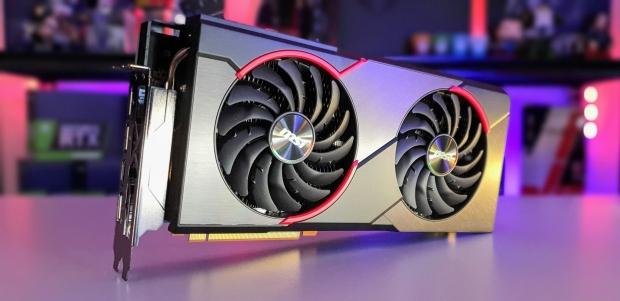
The Bottom Line
Introduction, Pricing & Detailed Specs
I've been through a bunch of different custom Radeon RX 5700 XT graphics cards now, with one of my favorites and best-performing custom Navi cards being MSI's own Radeon RX 5700 XT GAMING X. Now it's time to re view its sibling, the MSI Radeon RX 5700 GAMING X - a slightly cut down, but equally kick ass custom Navi card.
MSI hasn't changed much in terms of the cooling tech between the flagship RX 5700 XT GAMING X and the RX 5700 GAMING X, with the same great TWIN FROZR 7 cooler used on the new RX 5700 GAMING X. This means we have ZERO FROZR tech at play here for silent use when the card isn't under gaming loads, and it looks awesome, too.
The same backplate is on MSI's custom RX 5700 GAMING X and it looks mean inside of a gaming PC, with the Mystic Light RGB lighting making your gaming rig stand out from a crowd. Performance wise, you're going to find some great FPS in 1080p and 1440p games, and even no issues playing popular games like Apex Legends and Overwatch on a 21:9 monitor at 3440x1440 on the MSI RX 5700 GAMING X.
Detailed Specs
It wouldn't be a GAMING X card without some custom overclocking, with MSI pumping up the Navi 10 XL GPU inside of the RX 5700 GAMING X up to 1750MHz boost, up top 1725MHz game clocks, and 1610MHz base clocks. the 8GB of GDDR6 sits at its stock 14Gbps frequency.
MSI's custom RX 5700 GAMING X measures in at 297 x 58 x 140mm, so be sure to measure your system before you throw it in. If your mITX (or similar) gaming rig can handle it, the custom RX 5700 GAMING X is going to give your mini gaming PC some potent performance.
Pricing
MSI has its new Radeon RX 5700 GAMING X priced at $399... making it a little more expensive than the reference RX 5700 from AMD. You are getting a much cooler, and better looking RX 5700 for the additional money on the custom RX 5700 GAMING X.
Cooling Tech
Cooling Tech: TWIN FROZR 7
There is a LOT going on under the hood of MSI's TWIN FROZR 7 cooler, so let's dive right in.
First up, MSI uses an insanely thick and great-performing heat sink under the RX 5700 GAMING X. This is why the dual fans don't need to do much work when the card is at idle, and not much more work when the card is at load.
Speaking of the fans, MSI's custom RX 5700 GAMING X and its TWIN FROZR 7 cooler use TORX Fan 3.0 fans, with some new trims that improve the cooling experience.
If the card is under 60C (which it is until you start gaming) then the fans will not spin at all, something that MSI likes to call ZERO FROZR.
MSI uses a dedicated aluminum plate that covers the power delivery components on the card, providing ultimate cooling for the RX 5700 GAMING X.
Once again, MSI wants to provide the best cooling it can with TWIN FROZR 7.
The heat sink for the TWIN FROZR 7 on the RX 5700 GAMING X is tightly bolted onto the PCB, which provides better heat dissipation and strengthens the card itself.
Trust me, there's a LOT going on with this cooler -- with a big concentration put on the heat pipes underneath the cooler.
MSI uses a solid nickel-plated copper base plate on the TWIN FROZR 7-cooled RX 5700 GAMING X.
They also use premium thermal compound, too.
There's even some thermal padding on the GDDR6 and PWMs.
Detailed Look
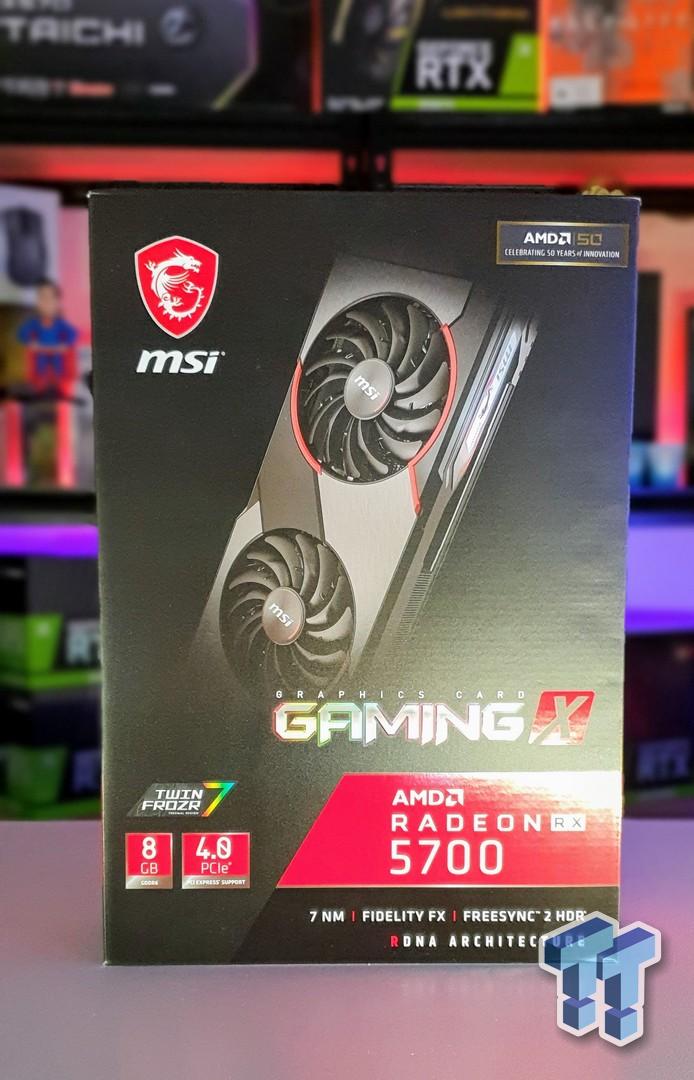
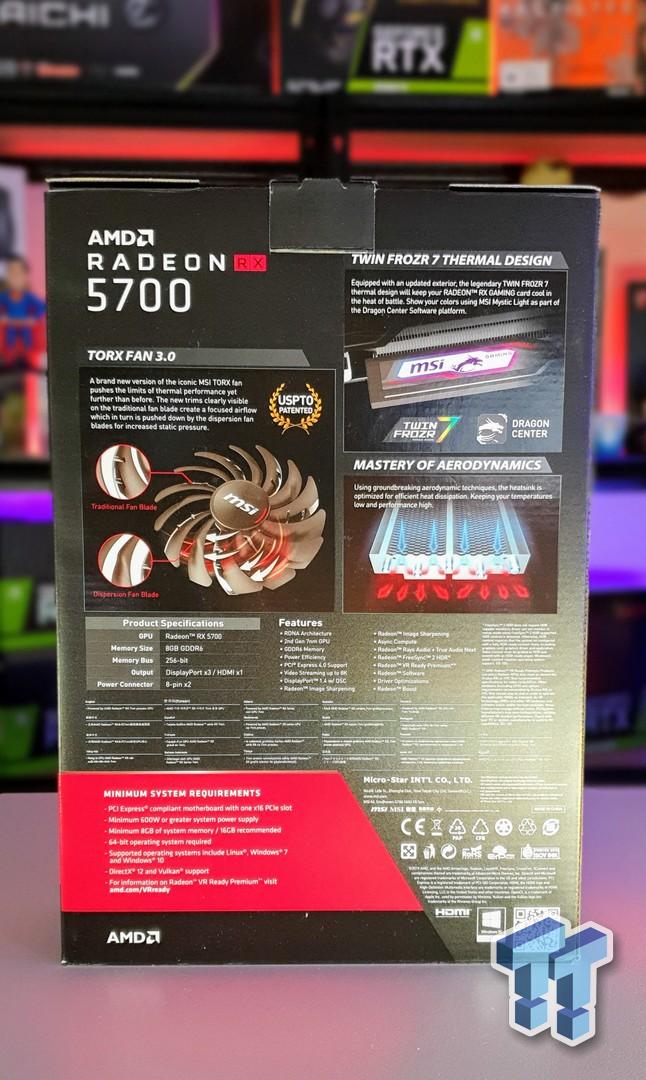
You'll never be disappointed with the packaging on a GAMING X-branded graphics card from MSI.
MSI's new Radeon RX 5700 GAMING X in all its glory, rocking out with its TWIN FROZR 7 cooler.
On the back we have that slick backplate, something that really shines inside of an RGB-lit gaming PC.
From the bottom of the card, the chunky heat sink can be seen -- with the card coming in as a near triple-slot card so you'll need some space in your rig.
The card feels even thicker from the top, with the MSI GAMING logo to the left and dual 8-pin PCIe power connectors to the right. I think that's a bit overskill for just an RX 5700...
A closer look at the heat sink and dual 8-pin PCIe power connectors.
You have 3 x DP and 1 x HDMI for display connectivity on the MSI RX 5700 GAMING X.
The tail end of the card and its 5 heat pipes poking through.
Test System Specs
Our New GPU Test Rig
Welcome to the latest revision of our GPU test bed, with our system being upgraded from the Intel Core i7-7700K to the Core i7-8700K. The CPU is cooled by the Corsair H115i PRO cooler, with the 8700K overclocked to 5GHz. We've stayed with GIGABYTE for our motherboard with their awesome Z370 AORUS Gaming 7.

We approached our friends at HyperX for a kit of their kick ass HyperX Predator DDR4-2933MHz RAM (HX429C15PB3AK4/32), with 2 x 8GB sticks for a total of 16GB DDR4-2933. The RAM stands out through every minute of our testing as it has beautiful RGB lights giving the system a slick look while benchmarking our lives away, while the Z370 AORUS Gaming 7 motherboard joins in with its own array of RGB lighting.
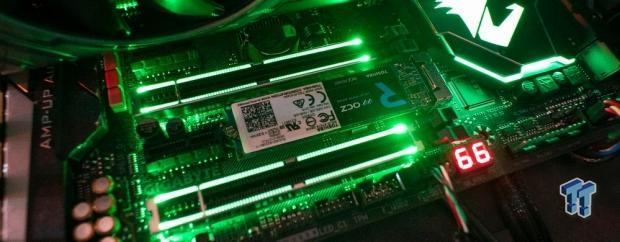
Detailed Tech Specs
- CPU: Intel Core i7-8700K @ 5GHz
- Cooler: Corsair Hydro Series H115i PRO
- MB: Z370 AORUS Gaming 7
- RAM: 16GB (2x8GB) HyperX Predator DDR4-2933
- SSD: 1TB OCZ RD400 NVMe M.2
- SSD: 512GB OCZ RD400 NVMe M.2
- PSU: InWin 1065W PSU
- Chassis: In Win X-Frame
- OS: Windows 10 Pro x64
Additional Images
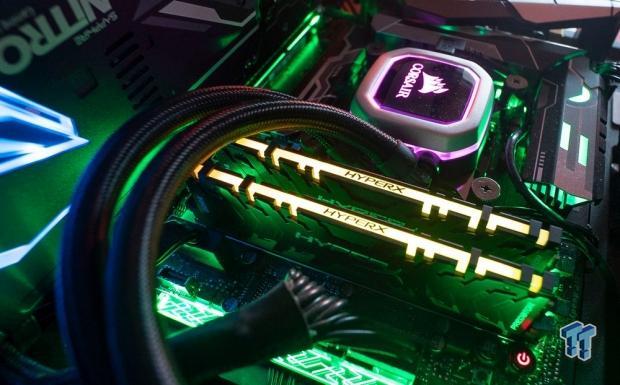
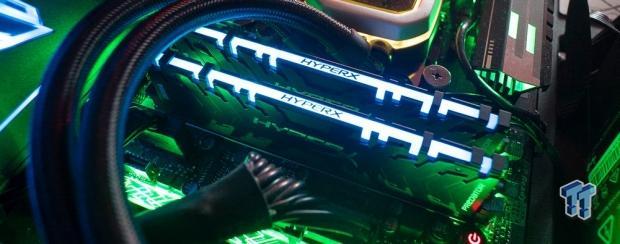
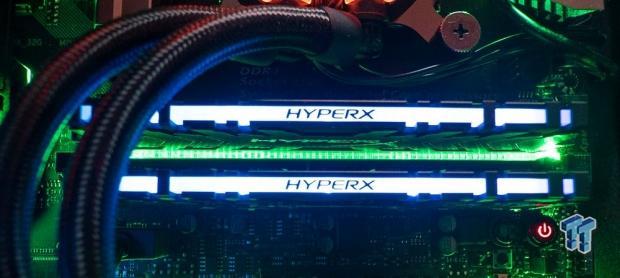
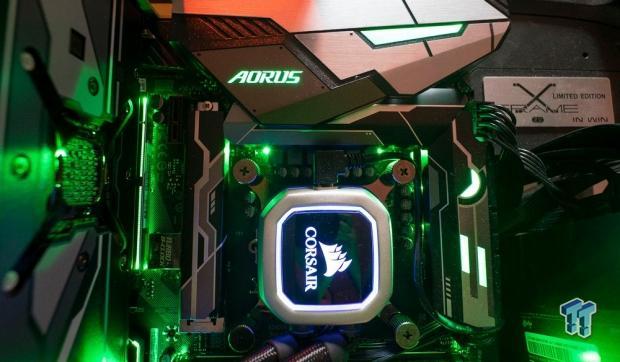
Benchmarks - Synthetic
3DMark Fire Strike - 1080p
3DMark has been a staple benchmark for years now, all the way back to when The Matrix was released and Futuremark had bullet time inspired benchmarks. 3DMark is the perfect tool to see if your system - most important, your CPU and GPU - is performing as it should. You can search results for your GPU, to see if it falls in line with other systems based on similar hardware.
3DMark Fire Strike - 1440p
3DMark has been a staple benchmark for years now, all the way back to when The Matrix was released and Futuremark had bullet time inspired benchmarks. 3DMark is the perfect tool to see if your system - most important, your CPU and GPU - is performing as it should. You can search results for your GPU, to see if it falls in line with other systems based on similar hardware.
3DMark Fire Strike - 4K
3DMark has been a staple benchmark for years now, all the way back to when The Matrix was released and Futuremark had bullet time inspired benchmarks. 3DMark is the perfect tool to see if your system - most important, your CPU and GPU - is performing as it should. You can search results for your GPU, to see if it falls in line with other systems based on similar hardware.
3DMark TimeSpy
3DMark TimeSpy Extreme
Heaven - 1080p
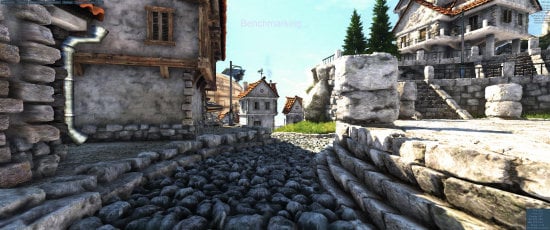
Heaven is an intensive GPU benchmark that really pushes your silicon to its limits. It's another favorite of ours as it has some great scaling for multi-GPU testing, and it's great for getting your GPU to 100% for power and noise testing.
Heaven - 1440p
Heaven - 4K
Benchmarks - 1080p
1080p Benchmarks
Gears 5 is the latest in The Coalition's huge franchise, with the game made on Unreal Engine 4. It looks great, and chews through even the latest GPUs. I benchmarked it at 1080p, 1440p, and 4K in a separate article and even did some 8K benchmarking at 7680 x 4320.
Borderlands 3 is also made on Unreal Engine 4 but developer Gearbox Software took it in a different route visually, to say the least. You'll want some high FPS in this game, and some of the more 'mid-range' cards do well while the game looks great. Once again, I tested this at 8K here.
Middle-earth: Shadow of War is a sequel to the popular Shadow of Mordor, which was powered by the Lithtech engine. When cranked up to maximum detail, it will chew through your GPU and its VRAM like it's nothing.
You can buy Middle-earth: Shadow of War at Amazon.
Far Cry New Dawn was developed by Ubisoft, and is powered the Dunia Engine, an engine that has been modified over the years for Far Cry and last used in Far Cry 5. Dunia Engine itself was a modified version of CRYENGINE, scaling incredibly well on all sorts of hardware.
Shadow of the Tomb Raider is one of the latest games to join our graphics card benchmark lineup, with the game built using the Foundation engine as a base, the same engine in Rise of the Tomb Raider. Eidos Montreal R&D department made lots of changes to the engine during the development of Shadow of the Tomb Raider to make it one of the best-looking games out right now.
1080p Benchmark Performance Thoughts
MSI provides some kick ass performance with its Radeon RX 5700 GAMING X, beating out the reference RX 5700 as expected. In games like Gears 5 you can run everything pretty much maxed out and still maintain 100FPS+ average.
Borderlands 3 can be maxed out at 1080p on the MSI RX 5700 GAMING X and you're still getting 71FPS, up 6FPS from the reference RX 5700 with 65FPS. Shadow of War is a punishing game at higher resolutions but here at 1080p we're still looking at a huge 124FPS average with the RX 5700 GAMING X.
Overall, better than reference RX 5700 performance at much quieter noise levels and operating temperatures.
Benchmarks - 1440p
1440p Benchmarks
Gears 5 is the latest in The Coalition's huge franchise, with the game made on Unreal Engine 4. It looks great, and chews through even the latest GPUs. I benchmarked it at 1080p, 1440p, and 4K in a separate article and even did some 8K benchmarking at 7680 x 4320.
Borderlands 3 is also made on Unreal Engine 4 but developer Gearbox Software took it in a different route visually, to say the least. You'll want some high FPS in this game, and some of the more 'mid-range' cards do well while the game looks great. Once again, I tested this at 8K here.
Middle-earth: Shadow of War is a sequel to the popular Shadow of Mordor, which was powered by the Lithtech engine. When cranked up to maximum detail, it will chew through your GPU and its VRAM like it's nothing.
You can buy Middle-earth: Shadow of War at Amazon.
Far Cry New Dawn was developed by Ubisoft, and is powered the Dunia Engine, an engine that has been modified over the years for Far Cry and last used in Far Cry 5. Dunia Engine itself was a modified version of CRYENGINE, scaling incredibly well on all sorts of hardware.
Shadow of the Tomb Raider is one of the latest games to join our graphics card benchmark lineup, with the game built using the Foundation engine as a base, the same engine in Rise of the Tomb Raider. Eidos Montreal R&D department made lots of changes to the engine during the development of Shadow of the Tomb Raider to make it one of the best-looking games out right now.
1440p Benchmark Performance Thoughts
Gears 5 still maintains good performance on the MSI RX 5700 GAMING X with 71FPS average, up from the 69FPS on the reference card. Borderlands 3 drops below 60FPS at just 50FPS average at 1440p, but even the 16GB of HBM2 on the Radeon VII isn't much better with 54FPS in comparison. The stock RX 5700 is behind at 47FPS.
Shadow of War is still pumping away at 83FPS (just 1FPS faster than reference here) but since it's not a twitchy first-person shooter 83FPS is a great result at 1440p thanks to the 8GB of GDDR6 on the 5700.
Shadow of the Tomb Raider and Far Cry New Dawn both offer far past 60FPS at 1440p, just a few FPS faster than the reference card here once again. These are still AAA games and quite gorgeous at 1440p to play, with MSI's custom RX 5700 GAMING X handling 1440p gaming without an issue here.
Benchmarks - 4K
4K Benchmarks
Gears 5 is the latest in The Coalition's huge franchise, with the game made on Unreal Engine 4. It looks great, and chews through even the latest GPUs. I benchmarked it at 1080p, 1440p, and 4K in a separate article and even did some 8K benchmarking at 7680 x 4320.
Borderlands 3 is also made on Unreal Engine 4 but developer Gearbox Software took it in a different route visually, to say the least. You'll want some high FPS in this game, and some of the more 'mid-range' cards do well while the game looks great. Once again, I tested this at 8K here.
Middle-earth: Shadow of War is a sequel to the popular Shadow of Mordor, which was powered by the Lithtech engine. When cranked up to maximum detail, it will chew through your GPU and its VRAM like it's nothing.
You can buy Middle-earth: Shadow of War at Amazon.
Far Cry New Dawn was developed by Ubisoft, and is powered the Dunia Engine, an engine that has been modified over the years for Far Cry and last used in Far Cry 5. Dunia Engine itself was a modified version of CRYENGINE, scaling incredibly well on all sorts of hardware.
Shadow of the Tomb Raider is one of the latest games to join our graphics card benchmark lineup, with the game built using the Foundation engine as a base, the same engine in Rise of the Tomb Raider. Eidos Montreal R&D department made lots of changes to the engine during the development of Shadow of the Tomb Raider to make it one of the best-looking games out right now.
4K Benchmark Performance Thoughts
I wouldn't recommend MSI's custom Radeon RX 5700 GAMING X for 4K gaming, but that doesn't mean it's not capable of 4K gaming. Gears 5 sees a sharp drop at 4K on the RX 5700 (custom or reference) with just 35FPS average on MSI's RX 5700 GAMING X.
Borderlands 3 is worse with just 27FPS at 4K, an identical result to the reference RX 5700 from AMD. Shadow of War dips below 60FPS average with 52FPS while Shadow of the Tomb Raider still manages 51FPS. The last two games wouldn't be too bad with some detail tweaks at 4K to maintain 60FPS.
Overall, you could drop the detail settings on some games and hit 60FPS at 4K on the Radeon RX 5700 -- if that's what you want. I would recommend dropping details at 4K for 60FPS+ over Ultra detail and 30FPS.
Thermals & Power
Power
MSI's custom Radeon RX 5700 GAMING X in our Intel Core i7-8700K test bed has the entire system using 220W, just 10W more than the reference Radeon RX 5700 graphics card. This is the same power as NVIDIA's reference GeForce RTX 2060 Founders Edition, and much less than even the RX 580.
Thermals
When it comes to thermals MSI has worked its magic on the RX 5700 GAMING X with its TWIN FROZR 7 cooler, with the card running at just 61C....compare this to the reference RX 5700 at 70C and you have more performance at significantly less temperature.
This means much less heat in your PC, and overall temperature drops on your CPU in some cases too depending on the cooling you're using. It's also the coolest operating graphics card on our stack now.
Final Thoughts
Why would you buy MSI's new Radeon RX 5700 GAMING X over the reference card from AMD or another custom card? Super-stable performance with great power efficiency and virtually silent -- at the least, so close to it all the time it doesn't matter.
If you want that extra oomph in performance you'll want to nab MSI's even better Radeon RX 5700 XT GAMING X, but if you can't quite afford that and want the next best thing that's when the RX 5700 GAMING X stands strong.
You're getting better-than-reference RX 5700 performance in a card that is silent until 60C and not that loud when the fans spool up to keep that Navi GPU and 8GB of GDDR6 cool. You're not going to see mass overclocking of the Navi 10 GPU on the MSI RX 5700 GAMING X either... so don't buy this expecting to OC it like mad because it simply has dual 8-pin PCIe power connectors.
For a card slightly lower-end compared to the RX 5700 XT GAMING X, the new MSI Radeon RX 5700 GAMING X still offers up 8GB of super-fast GDDR6 at 14Gbps, enough for high-FPS monitors at 1080p and 1440p, but with enough grunt to handle some games at 4K with no problems.
Wrapping up, MSI has yet another great offering with its Radeon RX 5700 GAMING X, another fine member of the growing custom Navi GAMING X family of graphics cards. If you were upgrading from an older-gen AMD Radeon R9 290X or RX 480, then you're going to get a huge upgrade here.

